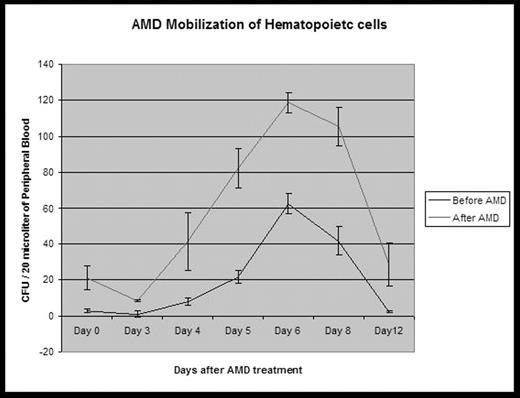Abstract
Hematopoietic progenitor cells (HPC) mobilized from bone marrow into peripheral blood (PB) are used to reconstitute hematopoiesis following myeloablative therapy. To date, a variety of agents including cytokines, chemotherapy and the combination have been used to mobilize HPC for autologous-HST. Cyclophosphamide (CY) and granulocyte colony-stimulating factor (G-CSF) are two of the most commonly used agents for HPC mobilization. Recently, AMD3100 (AMD), a bicyclam molecule that specifically and reversibly blocks SDF-1 binding to CXCR4, has been shown to have a unique HPC mobilizing capability characterized by a rapid mobilization within 1 to 2 hours after subcutaneous (sc) administration, compared with several days for G-CSF or CY. In contrast to AMD-induced mobilization, G-CSF and CY-induced HPC mobilization require functional neutrophils and an intact G-CSF receptor. We hypothesize that AMD will increase CY mobilization, and early intervention with AMD after CY treatment will increase the migration of HPC into PB in advance of neutrophil recovery. Wild type C57/BL6 mice were divided into 7 groups (n=3). One group was an untreated control and each of the other six groups received CY (200mg/kg) intraperitoneally on day 0, followed by single dose AMD (5 mg/kg sc) on days 3, 4, 5, 6, 8, and 12 after CY, respectively. WBC recovery and HPC mobilization into PB was evaluated with white blood cell (WBC) counts and standard colony-forming unit (CFU) assay, before and 2 hours after AMD administration. Our results showed that AMD can mobilize WBC within 30 minutes after treatment, reaching its peak effect in 2–3 hours with a 3–5 fold WBC increase, and a > 20 fold increase of PB neutrophils compared to baseline. We also demonstrated that AMD, CY, and CY + AMD increased the CFU/ml by 7.1 + 0.4, 22.6 + 8.4, and 42.9 + 16 fold over the baseline, respectively, reaching the peak mobilization for CY on day 6. The CFU/ml returned to baseline 12 days after treatment with CY or CY + AMD. Although the kinetics of mobilization of HPC after CY + AMD were similar to those seen with CY alone (Figure 1), significant mobilization of murine HPC after CY + A occurred 1–2 days (days 4–5) in advance of that seen with CY alone (days 6–8), 1–2 days in advance of neutrophil recovery (days 6–8) and coincident with period of maximal cytoxan-induced neutropenia. The addition of AMD to CY results in synergistic mobilization of HPC which occurs throughout the entire period of CY-induced mobilization. These data suggest that the addition of A to CY for PBSC mobilization will not significantly alter the kinetics of cytoxan-induced mobilization but may permit earlier collections in patients even before significant WBC recovery occurs.
Author notes
Corresponding author


This feature is available to Subscribers Only
Sign In or Create an Account Close Modal